

Damion Smy
Nissan Juke EV will use Leaf platform, due in 2026 - report
13 Hours Ago
There's a new V12 Ferrari in town and it's capable of doing over 340km/h. So, what's it like to drive in the wet? We wanted to find out.
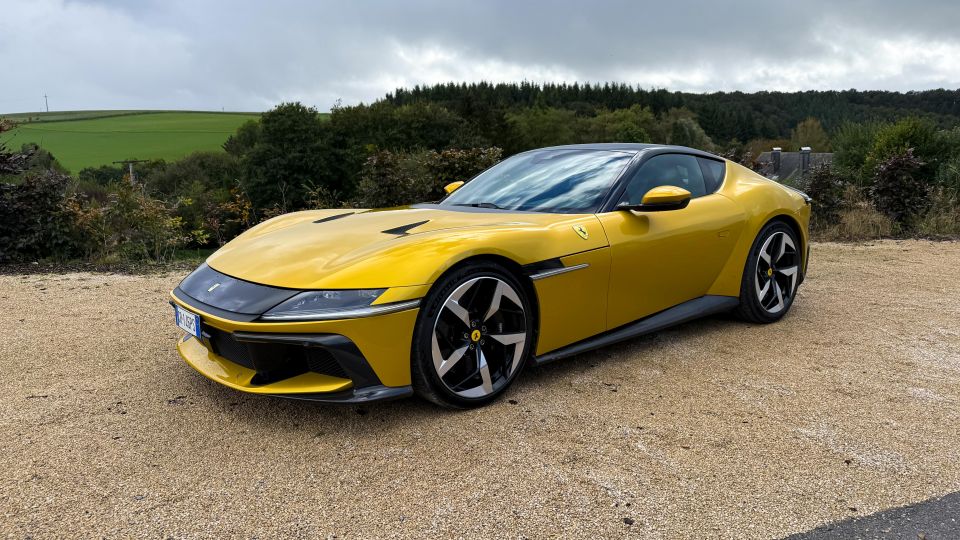
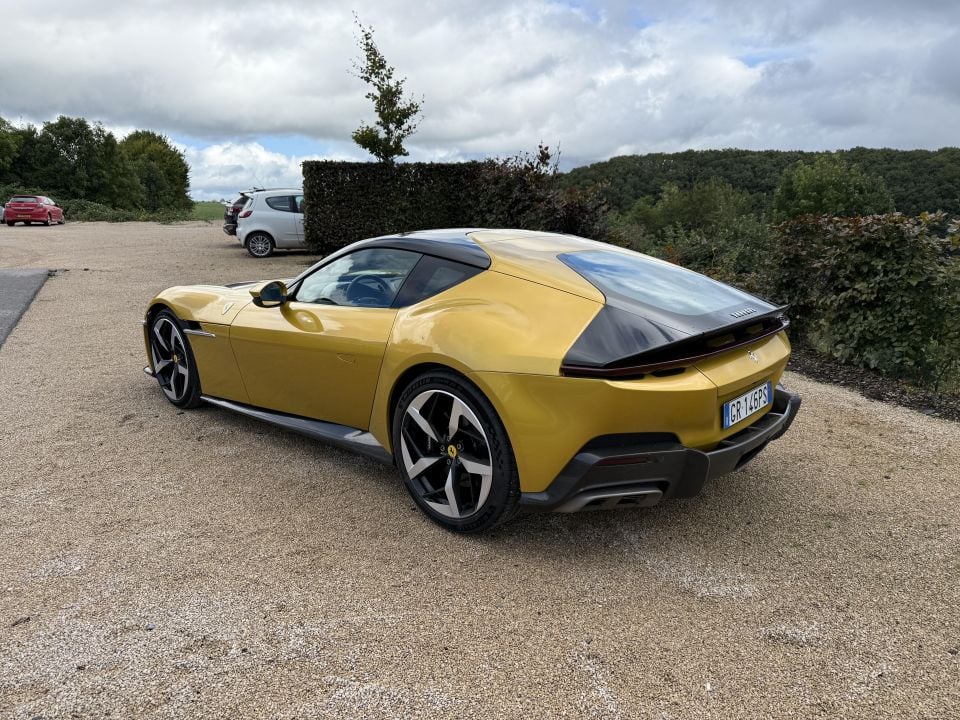

Founder

Founder


Founder

Founder
Where expert car reviews meet expert car buying – CarExpert gives you trusted advice, personalised service and real savings on your next new car.
Ferrari’s F140 engine has been around for a while now, but the storied Italian brand is constantly making improvements to its staple V12 product.

But there are only so many improvements you can make before the emissions police come along and tell you that a naturally aspirated V12 engine won’t cut it any longer.
In news that will please anybody with a pulse and ears, somehow Ferrari managed to get the 6.5-litre naturally aspirated F140 engine through all the approvals required to be sold in a number of historically strict automotive emissions markets.
As a result, there’s now a new V12 Ferrari GT car on sale and we’ve just had the chance to drive the 2025 Ferrari 12Cilindri at its global launch (albeit in very wet conditions!).
Unsurprisingly, the price of the Ferrari 12Cilindri won’t be much of a talking point among potential buyers, given access to the model is likely to be limited based on previous ownership.
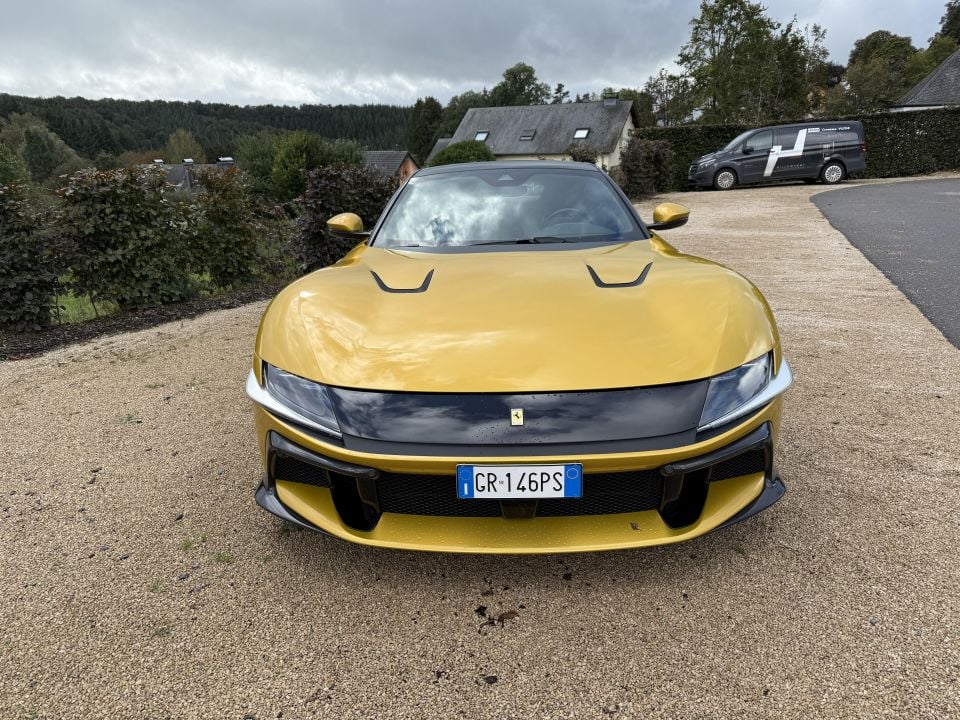
But, if you’re in a position to place an order, pricing starts at $803,500 before on-road costs for the entry-level 12Cilindri Coupe and steps up to $886,800 before on-roads for the retractable hardtop Spider version that is yet to be launched.
Seven years of complimentary servicing in included as part of the purchase price.
Buy your new car without the stress. It's fast, simple and completely free.

Great service from Travis and team, second time I have used this business would not hesitate to recommend them to anyone
Craig C.
Purchased a Ford Ranger in Sunshine Coast, QLD
CarExpert helped Craig save thousands on his Ford Ranger, now let us save you on your next new car.
Find a dealI don’t think anybody expects Ferrari to be the automotive equivalent of Silicon Valley when it comes to interior technology. But Ferrari really has stepped up its game when it comes to interior presentation and the level of technology on offer here.
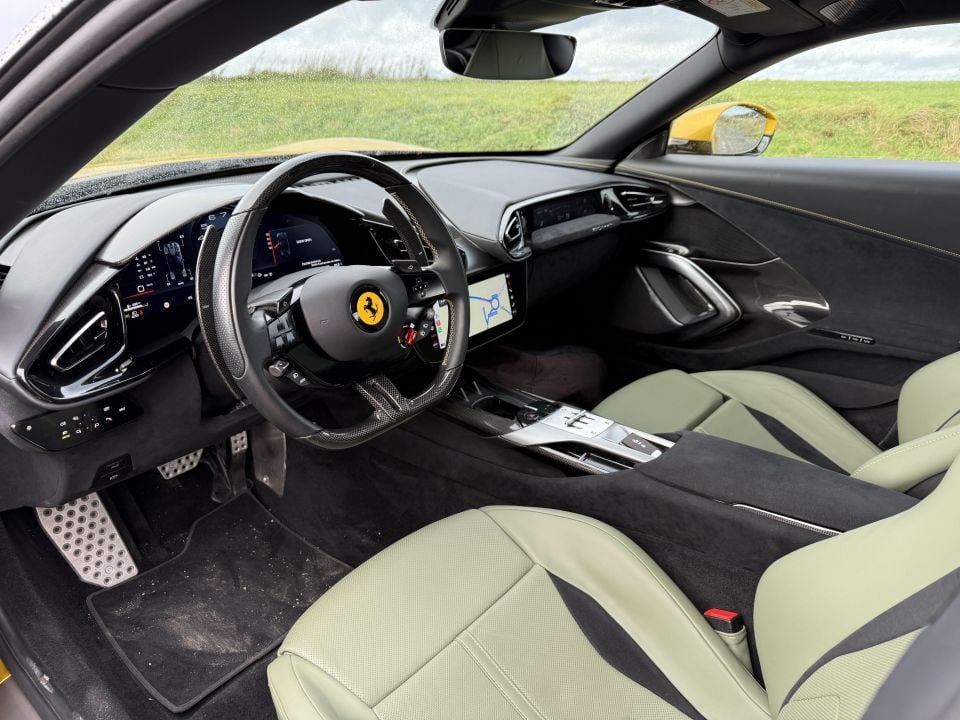
Yes, the interior looks beautiful and there are virtually endless interior and exterior customisation options, but there’s a new focus on bringing Ferrari interiors into the modern day and age in terms of tech.
Thankfully the focus hasn’t been on adding giant iPad-esque screens to the centre of the cabin or tech for the sake of it. Ahead of the driver is a 15.6-inch display that acts as mission control for all vehicle functions and controls. It has a degree of customisability such as a central tachometer versus dual instrument dials, the introduction of navigation elements, audio control visuals, etc.
It’s all driven using steering wheel-mounted controls that now feature indentations to help the driver locate them without taking their eyes off the road. There’s even a function that locks out the controls after a preset interval to prevent the driver bumping them unintentionally while driving.
With that said, it did take some time to get used to and was a little distracting. Some of the menu text elements are hard to read and turning off some of the advanced driver assistance systems (ADAS) controls while driving wasn’t intuitive. It also appears that some of the ADAS controls can’t be switched off entirely.
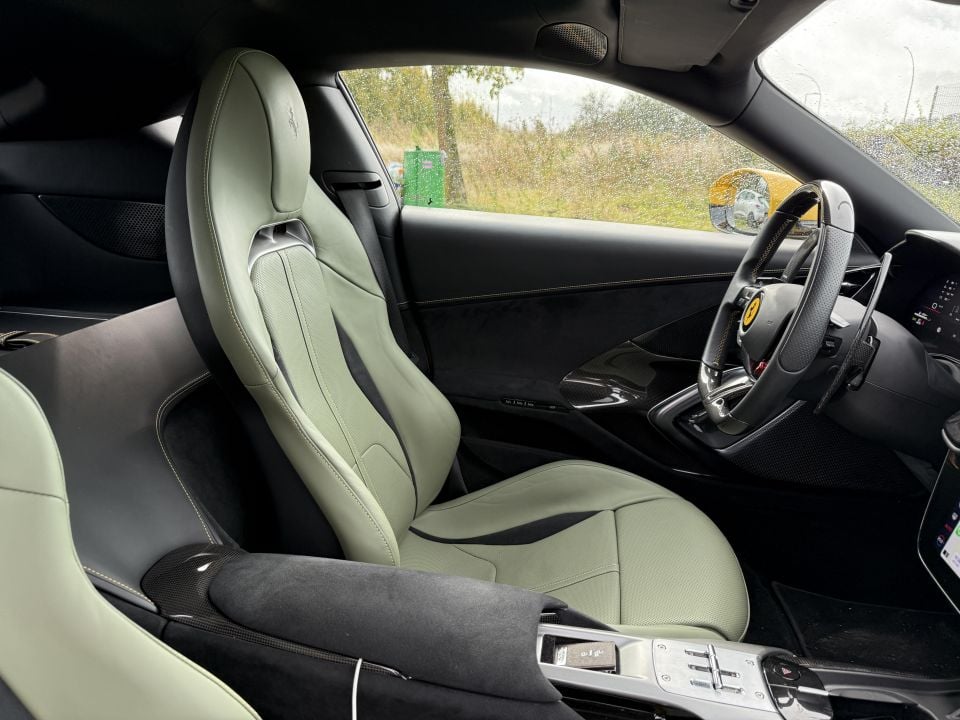
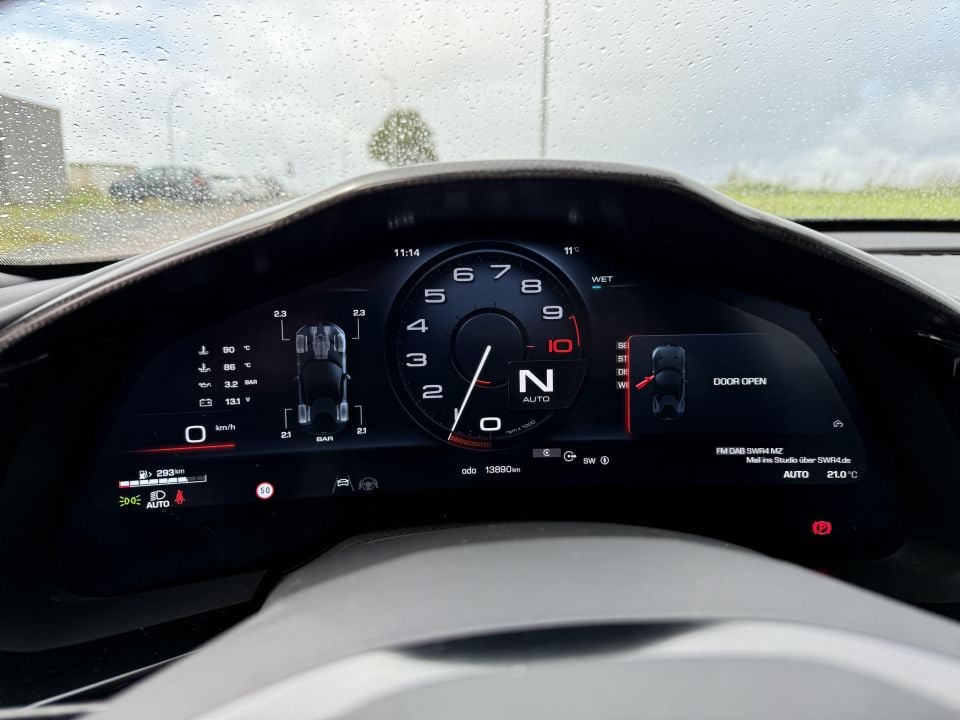
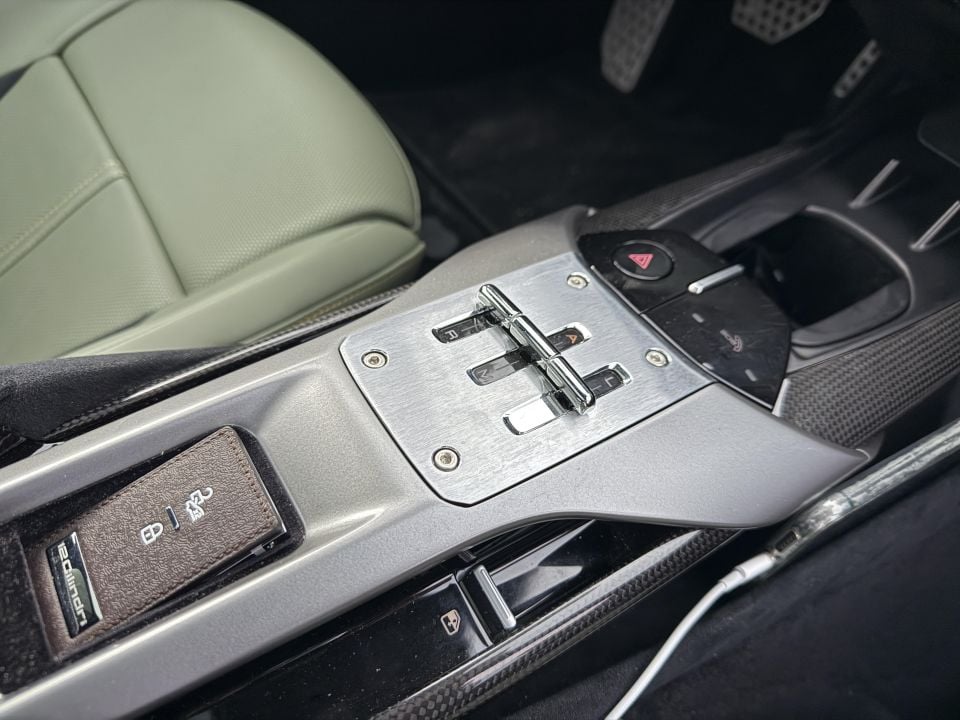
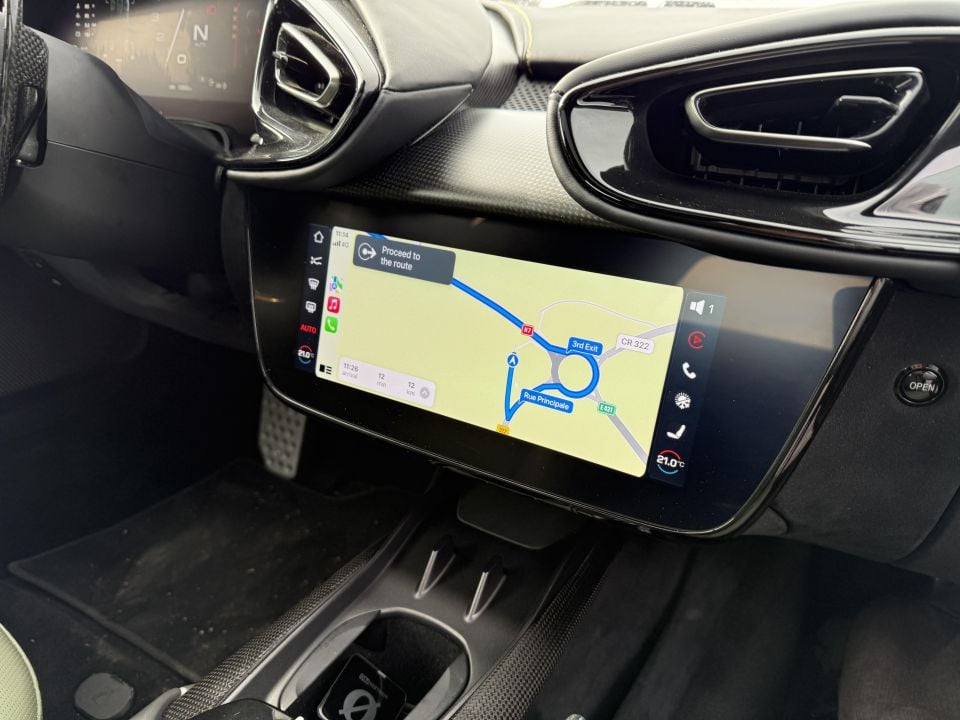
For example, even with the lane departure mechanism switched off there was an element of emergency lane keeping assistance that was still on in the background. We didn’t get enough time to properly play with the controls to find where this additional functionality was located, but we presume it can be entirely switched off.
Central to the cabin is a smaller 10.25-inch touchscreen display that controls things like climate, navigation, audio and also supports the vehicle’s smartphone mirroring capability. Apple CarPlay comes in the form of wired and wireless integration, while Android Auto is supported by wired integration only. There’s USB-C and 12V connectivity within the centre console.
Surprisingly, the cabin is really well proportioned from a storage point of view. The glovebox is reasonably sized, the centre console is deep enough and there is enough room for a bottle and even wireless phone charging.
Behind the driver and front passenger is adequate storage space for bags and other loose items.
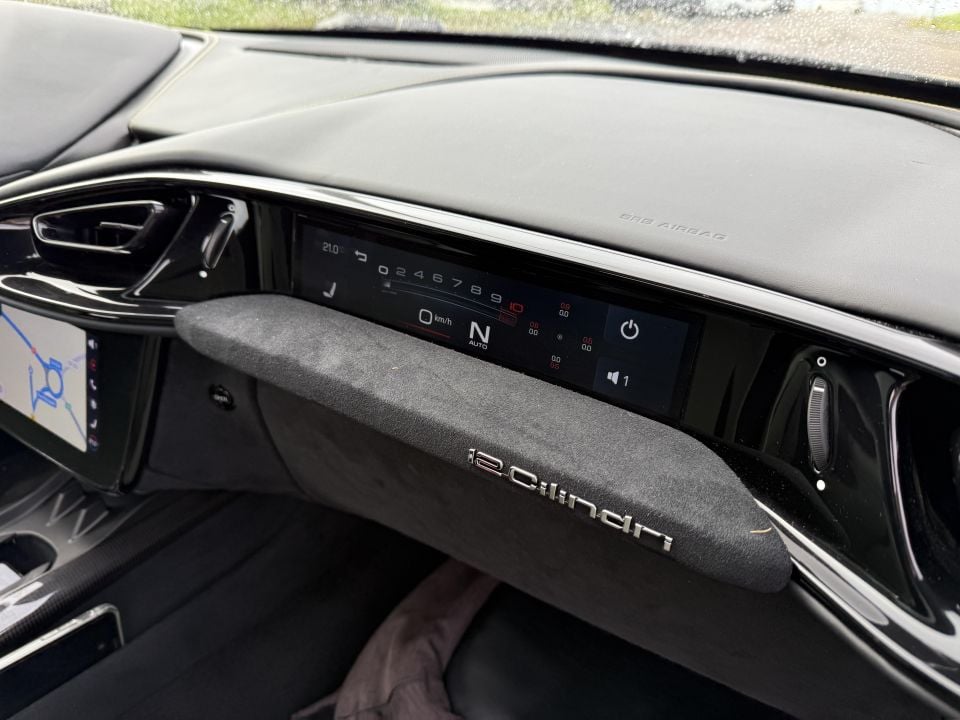

Creature comforts include heating and cooling for the seats and even a massage function to keep you motivated on those long drives.
You’ll also find a smaller 8.8-inch display on the passenger side of the vehicle that has become a go-to item for brands wanting to inject a bit more tech pizazz inside the cabin.
The passenger display is a feature we could live life without, but it’s there if your passenger needs something to keep them entertained.
There’s a stack of room in the boot for a vehicle this size, along with a subwoofer that forms part of the 15-speaker, 1600W Burmester sound system. An external charging port is located on the boot lid – a great convenience for keeping your vehicle charged during extended stationary periods.
If you like the thought of a naturally aspirated V12, you’re going to love both the way this one looks and the way it sounds.
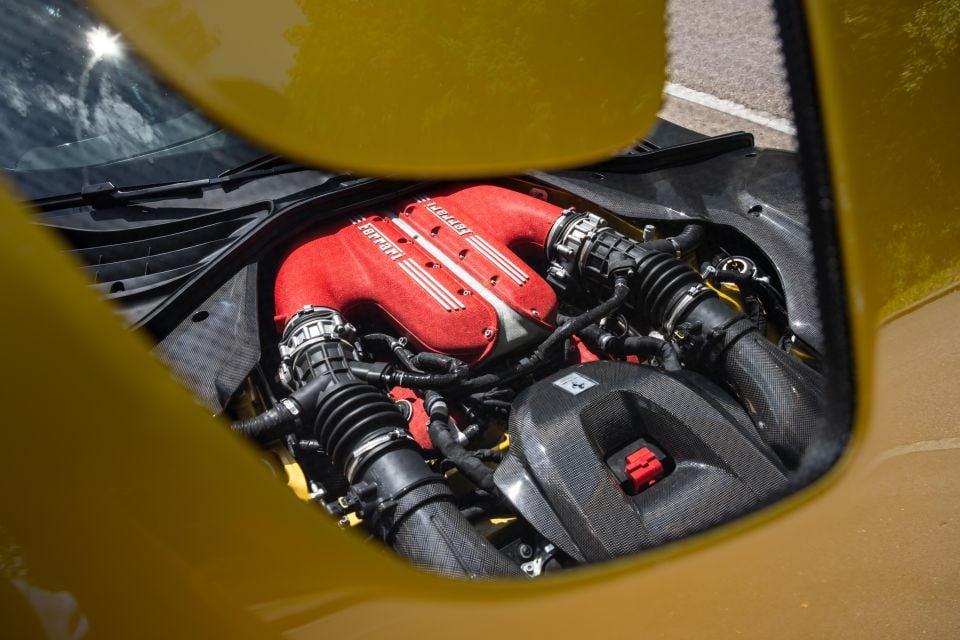
The immaculate under-bonnet presentation is revealed by flipping the clamshell bonnet forwards, via hinges about the front bumper.
It’s a genuine work of art and it’d be hard to imagine this not being the first thing you stare at once you park this in the garage at home. Exposed carbon and the iconic red engine cover are joined by exposed suspension members and gorgeous highlights that remind you why this is such an iconic drivetrain.
It’s a 6.5-litre naturally aspirated engine that produces 611kW of power and 678Nm of torque. The V12 is mated to an eight-speed dual-clutch automatic transmission with a redline of 9500rpm (watch the video to cop a listen of this).
The internal codename of this engine is the F140HD and it’s a comprehensive rework of its predecessor, the F140HC (that was found in the 812 Superfast and 812 Competizione). Changes include (but are not limited to) titanium connecting rods that offer a 40 per cent weight reduction over the previous engine, a rebalanced crankshaft that’s three per cent lighter and new pistons that are two per cent lighter.
The engine’s 48 valves are actuated by sliding finger cam followers, there’s a low-mass, low-friction technology borrowed from Ferrari’s F1 engines and fuel is pumped into the combustion chambers via a direct-injection system running at 350 bar.
To help create that iconic Ferrari V12 bellow, the headers are equal length and resonators are used to plumb real exhaust sound into the cabin. In fact, the back of the engine sits at the front of the dashboard – this front/mid-mounted location is iconic and helps deliver some of that natural sound to the occupants.
How did the engine meet the stringent emission requirements of today and tomorrow? Things like a ceramic catalytic converter are joined by a petrol particulate filter to meet Euro 6c emissions regulations for 2026 and beyond.
Key performance metrics are 0-100km/h in 2.9 seconds, 0-200km/h in 7.8 seconds and a top speed of 340km/h.
“It is not the top of the range in terms of performance,” says Ferrari’s chief marketing and commercial officer, Enrico Galliera. “It is the top of the range in terms of performance and comfort.”
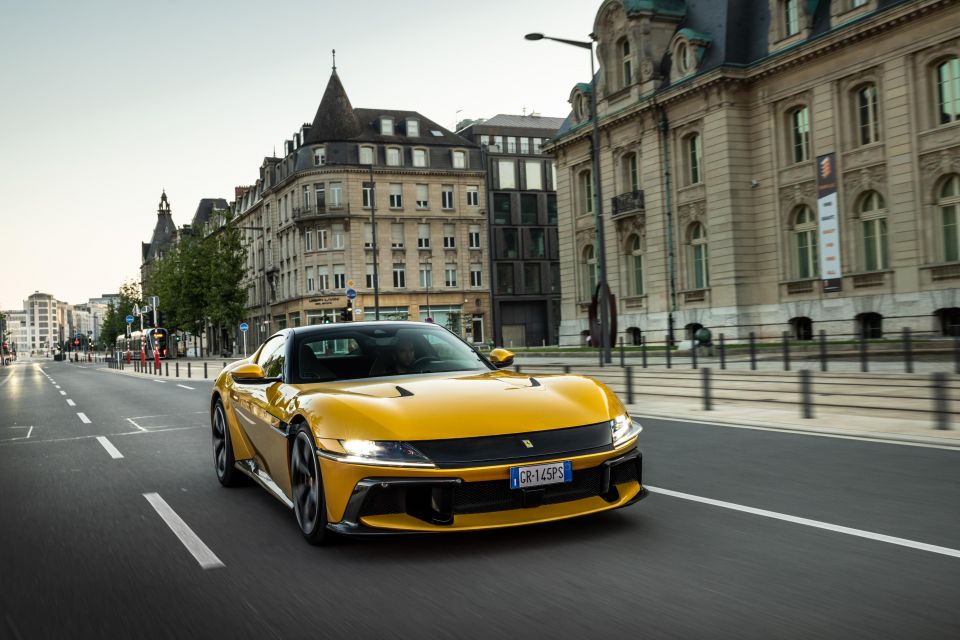
That kind of sums up what this car is all about. Yes, it delivers performance, but it’s not about outright performance at the cost of comfort.
When you hit the steering wheel-mounted starter button the V12 fires to life with an exciting burst. It feels every bit a performance car at idle. But once you set off, the performance car element takes a back seat.
The steering is super light, the ride is incredibly comfortable and there’s a smooth transition between gears. In fact, the car is often already in sixth gear by about 50km/h – it’s all about serenity and comfort ahead of audaciousness.
It was absolutely bucketing down on both days during the launch event in Luxembourg. So Wet mode was called for, for most of the drive.
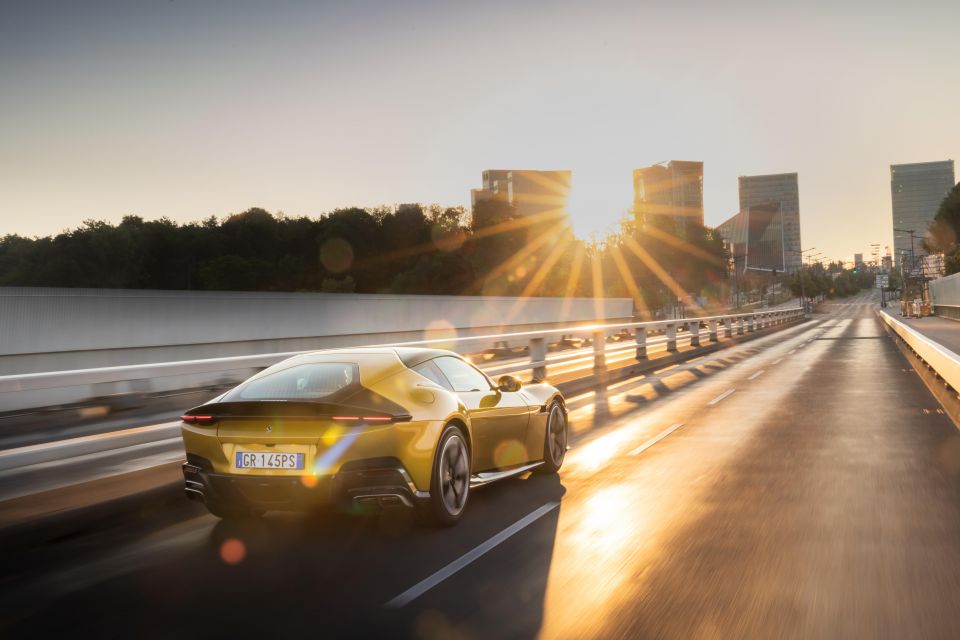
The Wet mode is fascinating because the thing in the back of my mind as we set off was how to properly manage more than 600kW of power from a rear-wheel drive Ferrari on wet, narrow country roads.
It genuinely took quite a bit of provocation for the vehicle to enter a low traction state. Even if you’re being greedy with the throttle, you have just over 600mm of rear tyre coverage on the road. The Michelin Pilot Sport S 5 tyres on the road cars measure in at 315mm wide each – more than enough to keep things in check if you aren’t being silly.
Wet mode also has adequate traction and stability control finesse to allow the vehicle to accelerate sufficiently without making the driver feel like they need to be a professional race driver in wet conditions.
That level of comfort translated from the steering to the ride. Magneride adaptive damping allows the car to feel like a Bentley instead of a race car in its comfort setting. It soaks up bumps beautifully and makes the mundane task of day-to-day driving carefree.
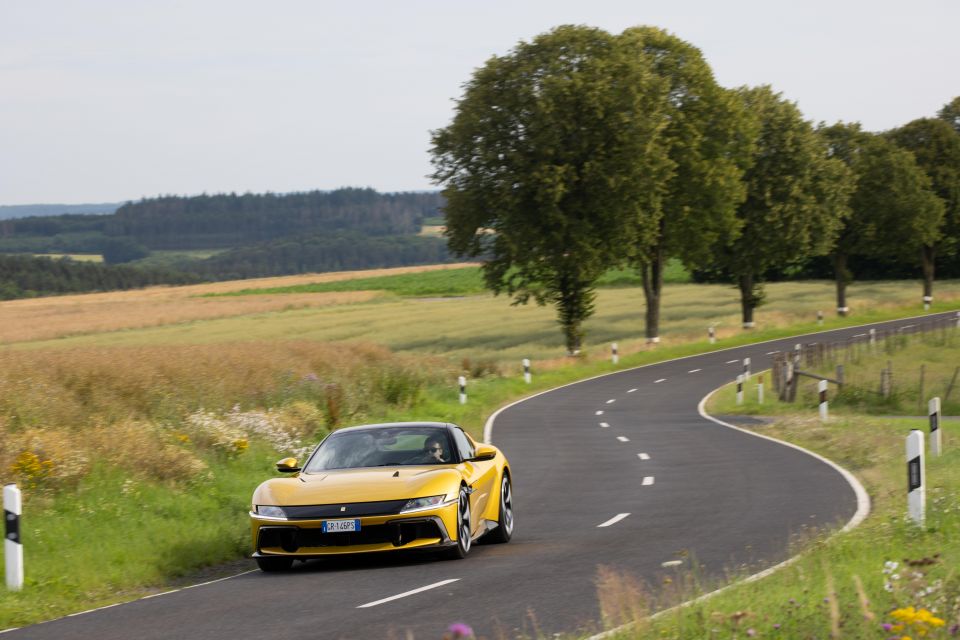
The only thing worth pointing out was a degree of sideways movement at the rear-end when hitting small bumps at low speeds. It’s something you experience in vehicles with a live rear axle and while it wasn’t the end of the world, it was noticeable and could have been due to higher tyre pressures as opposed to a systemic suspension geometry issue. It wasn’t noticed at higher speeds.
As parts of the road dried out slightly we were able to push the car a little harder in Sport mode. You immediately notice a much higher degree of stability control latitude in Sport mode. The ride feels firmer (although ‘bumpy road’ can be selected with a push of the Manettino dial), but isn’t over the top or overly firm.
What becomes evident as you get on is how eager and free spinning this V12 is. Moving 12 cylinders requires a lot of mechanical work, but it hustles from 2000rpm to 9500rpm effortlessly. And the noise as you approach 9500rpm is nothing short of breathtaking.
It’s so incredibly sonorous and vocal both inside and outside the cabin that you’d never know it had a tonne of emissions control equipment on board (not literally!).
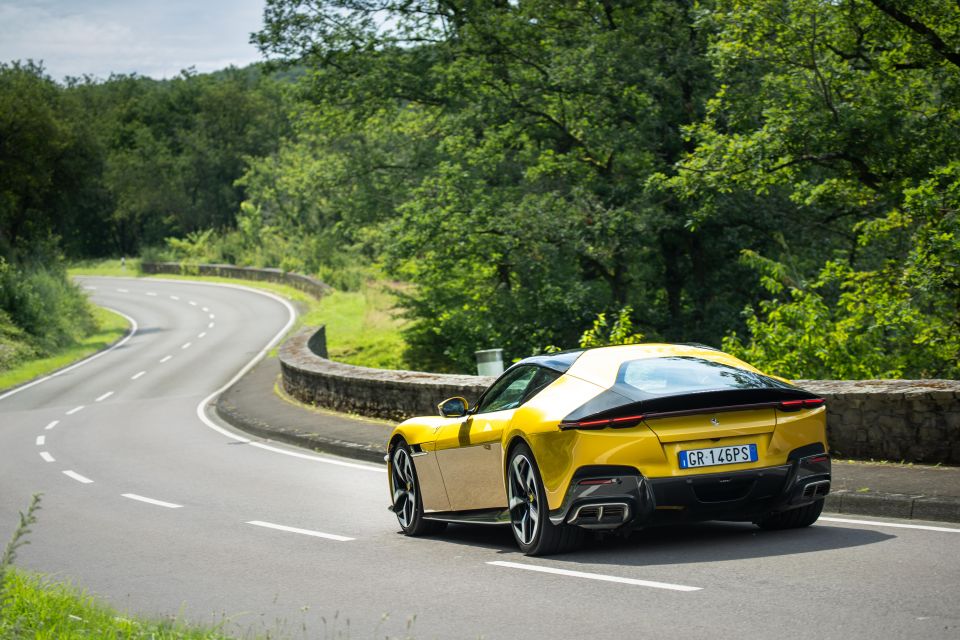
Even in Sport mode, the steering stays on the light side, but the 12Cilindri rotates about the front-end with such ease that you’d never pick it for a front-engined car. That’s partly thanks to integrated rear-wheel steering. It only contributes around three degrees of input at low speeds and just one degree at high speeds, but it helps liven up the rear without compromising traction.
The brakes are also supremely good – not because they are carbon ceramic – but because of the ABS EVO brake-by-wire technology used within them.
The ABS EVO system works in conjunction with a six-way chassis dynamic sensor to better understand the direction of vehicle movement at any given point in time. This sensor offers a much better estimation of vehicle speed across three axes and when fed into the ABS EVO system this information allows the vehicle to take greater advantage of the longitudinal tyre surface to exploit threshold braking.
It also uses this sensor and pedal effort to understand the road surface to deliver better braking during cornering and switchbacks where there is constant change in the level of grip available.
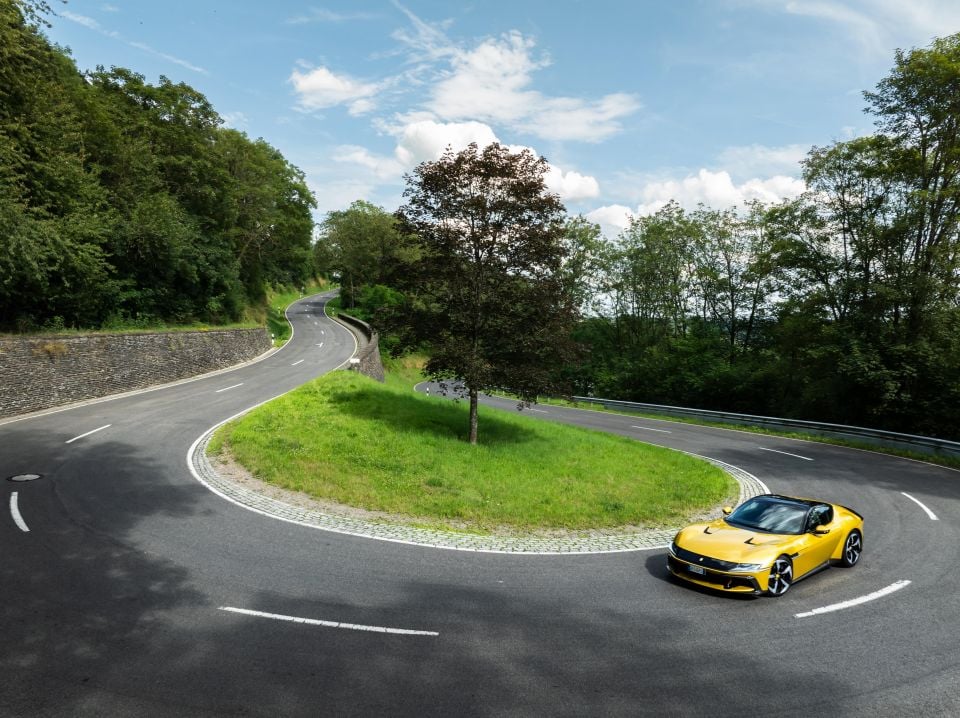
Inside the cabin, the driver also experiences uncompromised levels of pedal feel, which isn’t the case in a non-brake-by-wire system. It’s hard to describe, but it’s best explained in the context of an electric vehicle that uses regenerative braking (bear with me here).
In an electric vehicle if you enter a braking zone that has something like a tram line or pot hole ahead of it that the braking/regen wheel moves through, there is a brief moment where regen is stopped (because it’s an assumed slip condition and you don’t want the vehicle decelerating during this slip condition). The driver notices that as a decrease in deceleration and thus inputs more pedal force.
When the vehicle realises it isn’t in a slip condition (when the tyre is done falling into the pot hole or change in road surface), regen comes back on and there is a sudden increase in deceleration because the driver had applied more pedal force. It’s this pedal feel change that the ABS EVO system looks to avoid.
In the context of a naturally aspirated Ferrari, this can be during times when you have variable road surfaces due to moisture, debris or perhaps a degree of brake fade or tyre friction limit. In these instances an electronically-controlled brake-by-wire system can offer more consistent pedal feel during threshold braking and while braking through switchbacks that would otherwise normally upset the vehicle’s dynamics due to a lack of pedal feel.
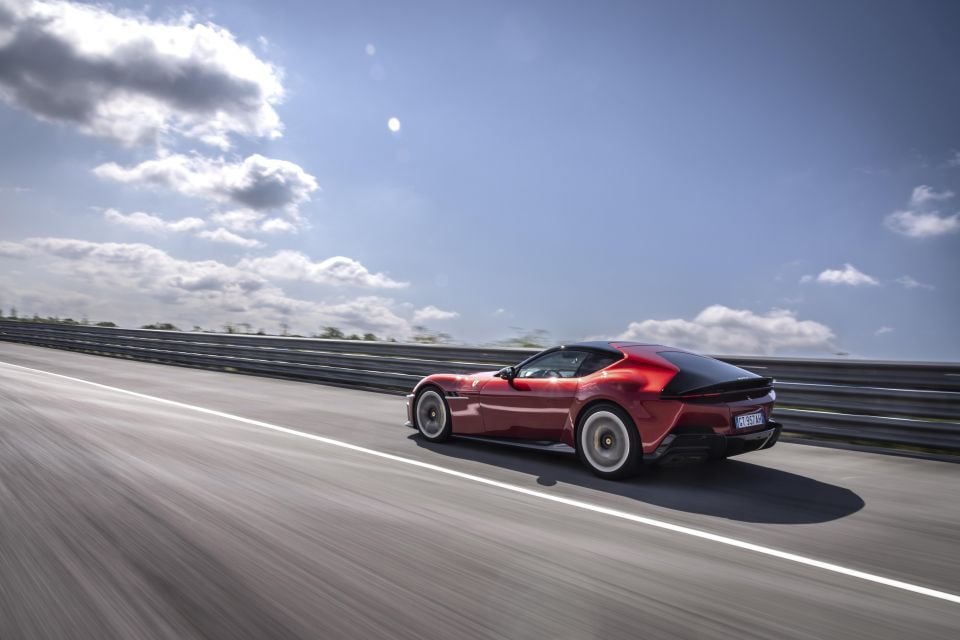
It’s an awesome implementation and technology that will soon find its way into more cars as manufacturers learn to properly tune the technology. It also means that the 296GTB, which debuted this technology, can use the same controller as the 12Cilindri, but ultimately offer a different level of pedal feel to suit its character. In the 12Cilindri it means a longer pedal travel and a more comfortable braking experience, where the 296GTB aims for sharper and more aggressive stopping feel.
Now that you understand why it exists, how does it work in practice? Surprisingly, even with such wet driving conditions, the car stopped on a dime. The huge tyre contact patch front and rear helps with that, but there was an additional degree of confidence that helped with driving faster in such treacherous conditions, knowing the vehicle could happily pull up in time.
Part of the stopping equation is the aero employed both under and on top of the 12Cilindri’s skin. Beneath the vehicle you’ll find ground effects, vortex generators and a huge rear diffuser designed to disrupt airflow out the back.
These elements pair with a set of active aero wings on either side of the boot that raise and lower depending on vehicle speed as well as throttle and brake inputs. In total, the system can provide an additional 50kg of downforce at 200km/h, which helps contribute to the car’s almost 350km/h top speed.
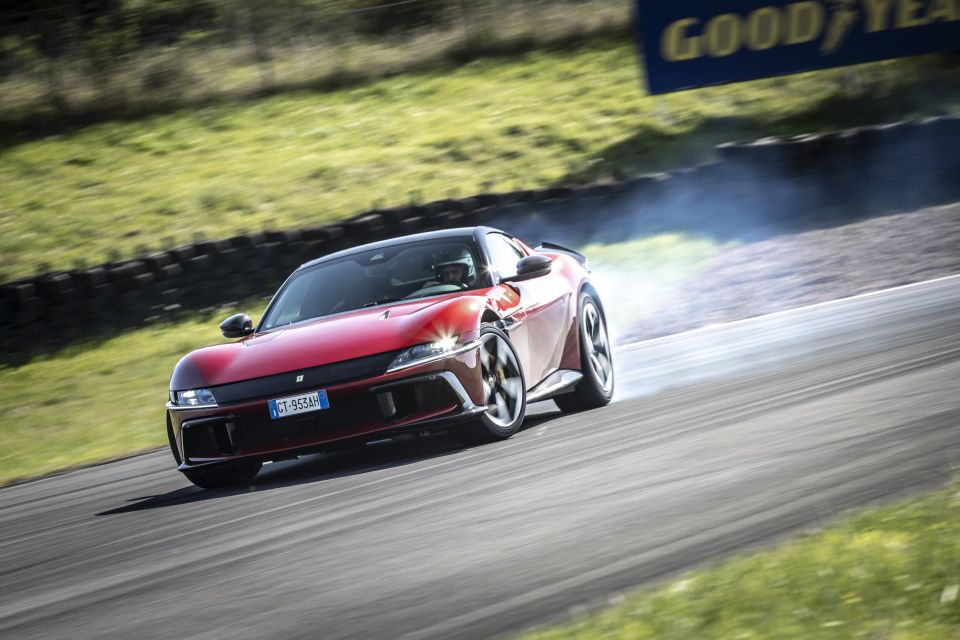
Where expert car reviews meet expert car buying – CarExpert gives you trusted advice, personalised service and real savings on your next new car.
We had the chance to do two laps of the Goodyear tyre proving ground in Luxembourg, to better experience the 12Cilindri in closed conditions. While it was still sopping wet, it allowed us to bring the car closer to its limit of adhesion in a controlled environment, and it was genuinely remarkable how much traction was available before it threw in the towel.
What was even more impressive was riding shotgun with one of Ferrari’s unhinged development drivers, who didn’t seem all that fazed by the huge amounts of water all over the track. In the hands of a professional who treated the vehicle like an MX-5, the huge amount of work that has gone into this platform became clearly evident and its performance in these conditions blew us away.
It’s easy to underestimate just how much of an achievement this car is. And it’s just as easy to read this review and assume it’s all just gushing because it’s a Ferrari and driving any Ferrari will always be good.
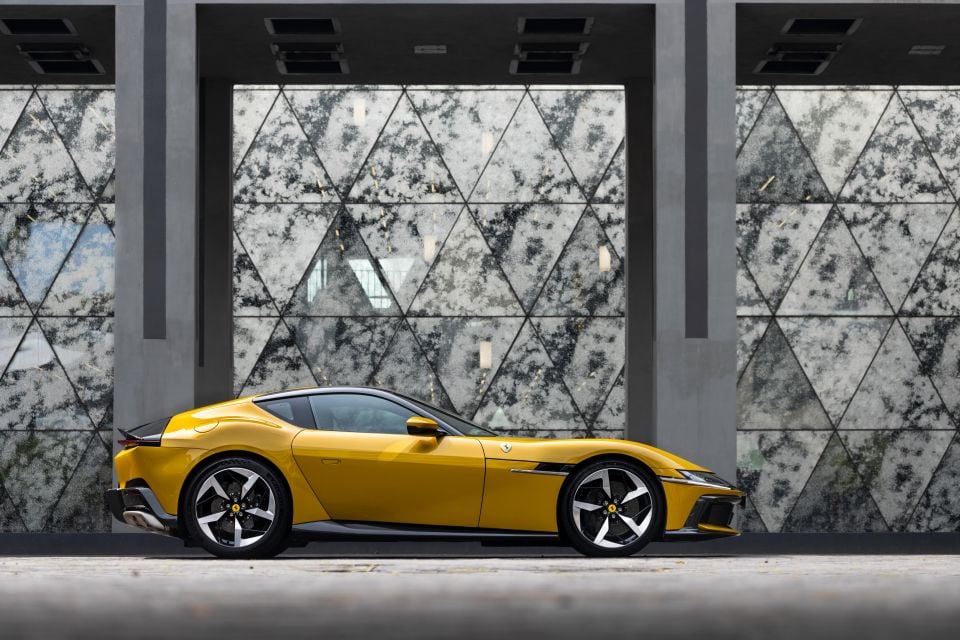
Ferrari is a company that develops everything from an entry-level sports car like the Roma to an SUV like the Purosangue and everything in between, plus the odd hypercar.
You can’t just stick a V12 engine under the bonnet of a car, design a fresh exterior and call it day. There’s a huge amount of work that goes into aero, safety, technology, equipment and the tuning of systems like ABS EVO and Magneride suspension, and that’s what makes this supercar a truly enjoyable cruiser that can become a razor-sharp track tool at the flick of a Manettino switch in less than a second.
It’s capable both in the hands of an average punter and a race car driver and it doesn’t intimidate you in the way older Ferrari V12s did – but is no softer because of it.
The 12Cilindri is the result of a remarkable engineering effort and the latest example of why Ferrari, which doesn’t have the luxury of being able to lean on sister brands like Lamborghini does, rightly commands so much respect at this exclusive end of the automotive landscape.
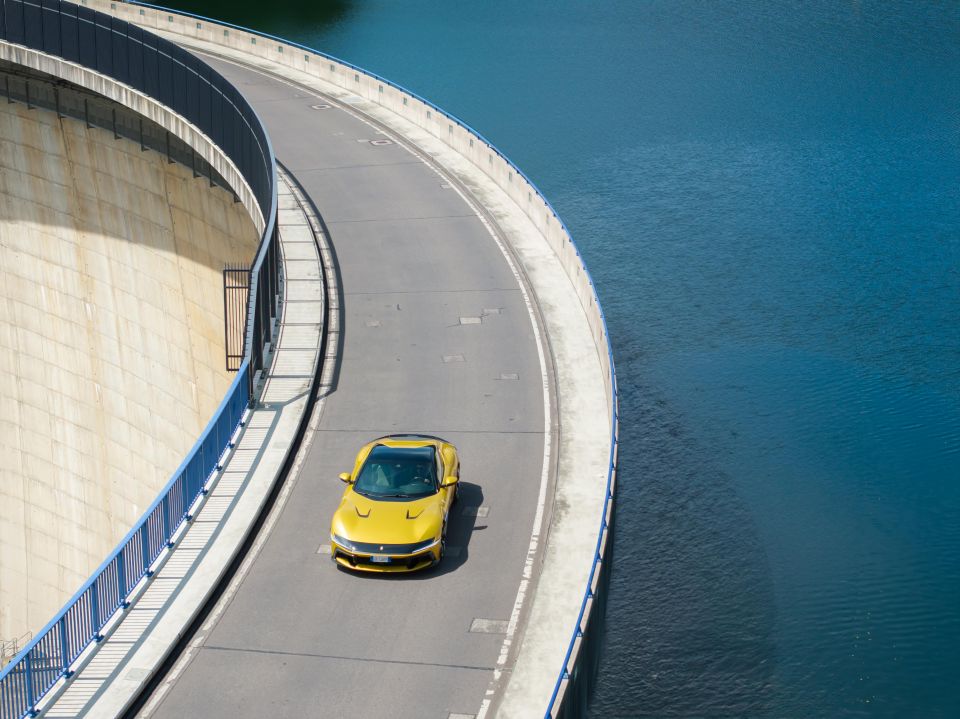
Interested in buying a Ferrari 12Cilindri? Get in touch with one of CarExpert’s trusted dealers here
Click the images for the full gallery
Where expert car reviews meet expert car buying – CarExpert gives you trusted advice, personalised service and real savings on your next new car.
Paul Maric is a CarExpert co-founder and YouTube host, combining engineering expertise with two decades in automotive journalism.


Damion Smy
13 Hours Ago


Damion Smy
16 Hours Ago


Damion Smy
19 Hours Ago


Damion Smy
21 Hours Ago


Damion Smy
21 Hours Ago


Damion Smy
22 Hours Ago